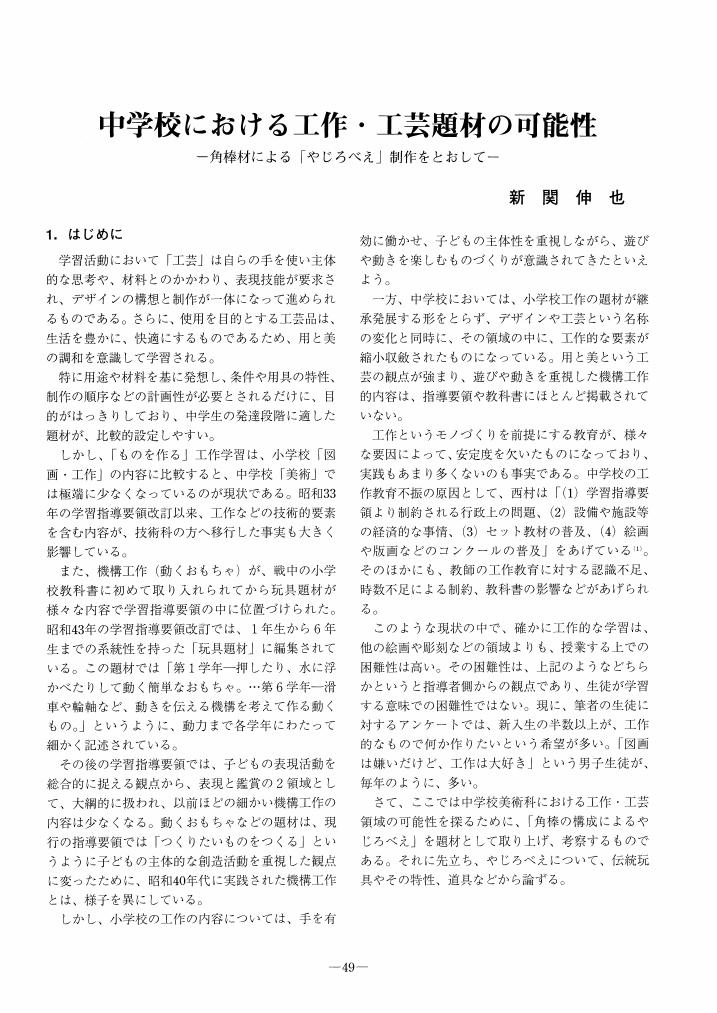1 0 0 0 OA 講演要旨 原始人の生活と美術
- 著者
- 木村 重信
- 出版者
- 日本美術教育学会
- 雑誌
- 美術教育 (ISSN:13434918)
- 巻号頁・発行日
- vol.1958, no.40, pp.17-25, 1958-02-15 (Released:2011-08-10)
1 0 0 0 小学校における鑑賞学習指導の現状と課題
- 著者
- 松岡 宏明
- 出版者
- 日本美術教育学会
- 雑誌
- 美術教育 (ISSN:13434918)
- 巻号頁・発行日
- vol.2016, no.300, pp.34-41, 2016
This paper reported on the current situations and various issues concerning art appreciation education in elementary schools. We did a survey using questionnaires of elementary school teachers all over the country and had 784 responses. From an analysis of the result, two hypotheses were supported. 1. Though the study of art appreciation education has been developed recently in the world of art education, the practice has not spread to elementary schools sufficiently. 2. Teachers of elementary schools want an index of goals and guidelines for the evaluation of art appreciation education. To encourage better art appreciation education, our research team will make rubric for art appreciation for each stage of child development.
1 0 0 0 OA 推古時代の仏像 講座 美の歴史 日本2
- 著者
- 源 豊宗
- 出版者
- 日本美術教育学会
- 雑誌
- 美術教育 (ISSN:13434918)
- 巻号頁・発行日
- vol.1952, no.6, pp.10-13, 1952-10-25 (Released:2011-08-10)
1 0 0 0 OA 美しいものに感ずる心を育てる
- 著者
- 原 繁生
- 出版者
- 日本美術教育学会
- 雑誌
- 美術教育 (ISSN:13434918)
- 巻号頁・発行日
- vol.1965, no.121, pp.15-16, 1965-08-01 (Released:2011-08-10)
1 0 0 0 旧山田寺仏頭の場合
- 著者
- 林 堤和
- 出版者
- 日本美術教育学会
- 雑誌
- 美術教育 (ISSN:13434918)
- 巻号頁・発行日
- vol.1975, no.213, pp.6-11, 1975
1 0 0 0 OA 中学校における工作・工芸題材の可能性
- 著者
- 新関 伸也
- 出版者
- 日本美術教育学会
- 雑誌
- 美術教育 (ISSN:13434918)
- 巻号頁・発行日
- vol.1998, no.277, pp.49-54, 1998-12-01 (Released:2011-08-10)
- 参考文献数
- 9
1 0 0 0 OA 美術鑑賞教育のタイポロジー
- 著者
- 赤木 里香子 森 弥生 山口 健二
- 出版者
- 日本美術教育学会
- 雑誌
- 美術教育 (ISSN:13434918)
- 巻号頁・発行日
- vol.2006, no.289, pp.8-15, 2006-03-01 (Released:2010-10-20)
- 参考文献数
- 5
- 被引用文献数
- 2
In this paper we give a typology designed for classifying art appreciation instructions in secondary schools. Two dichotomies are set. The first is to ask how instruction is made; do teachers get the appreciation of art works based on historical and cultural knowledge or students' own judgment? The second is to ask what the aim of instruction is; is it a preparation for making art works or a step for other kinds of broad activities. Combining the two dichotomies art appreciation instructions are divided into four types. The benefit of the typology does not reside in categorizing function itself but in making clear what the point of each instruction is. We also give an example in which a certain art appreciation lesson unit is designed properly with the typology.
1 0 0 0 子どもの純粋な感性にふれて
- 著者
- 永広 兆子
- 出版者
- 日本美術教育学会
- 雑誌
- 美術教育 (ISSN:13434918)
- 巻号頁・発行日
- vol.1993, no.267, pp.1, 1993
春、桜前線の北上にしたがい本校の校庭にも桜が咲いた4月1日、私は今福小学校に赴任した。<BR>校門をくぐった時、桜の大木が私を迎えてくれた。桜はもうすぐ満開の感を示している。子どもたちの入学式4月9日には満開になってほしいなと心待ちした。聞けば、この校門の桜は毎年入学式ごろが満開だそうである。<BR>入学式当日は満開の桜の下を新入生がやってくる。親子つれだって桜の木を背景にカメラにおさめている。式後、恒例で桜の木の所で入学の記念写真を撮る。撮り終ると子どもたちは黄色い帽子に散る花びらを追いかけ歓声をあげながら父母と共に校門を出ていく。何ともほほえましい光景があちこちで見られ, 明日からの子どもたちの姿が想像された。<BR>桜の木ってすごいな、これ一本でも子どもたちにあれだけ感動を与える。その存在の大きさに改めてこの大木を見あげたものである。青い空にやわらかいピンクの色の桜花が何ともいえない色あいで私の目を楽しませてくれた。<BR>新入生と上級生の対面式をした日、校庭は桜吹雪が舞って、地面は白いジュータンと化した木の下では、子どもたちが帽子に舞う花びらを受けようと駆け回る。その輪が何重にも広がって、新入生と上級生が入り交じって仲よく駆けていた。さらに私を驚かせたのは、その日の夕暮れ、二年生の男の子と母親が学校を訪れたことである。二年生の教室は今年から二階になっている。二階の窓から見る桜は子どもたちには別の視点から見ることになるので、一年生で見あげた時と違う美しさを感じることができ、大変感動したのだろう。「お母さんにも見せてあげたい」といって勤めから帰った母親を案内してやってきたのである。母と子は夕暮れ時から夜桜の鑑賞ということになった。夜桜を愛でる母と子の光景にも心おどらされた。母を連れ出した子ども、子どもの感動を一緒に、子どもの心になって感じてやろうとする母親、一日の勤めの疲れも忘れて母と子が同じ視点で桜を愛でながら語りあって帰った。本校にはこんなにも感性豊かな子どもがいるのかと思うと、私は前途が明るくなると同時に、この美しい感性を大事に育てることの重大さを痛感した。<BR>現在の子どもには季節感は失われがちで、感性や感受性の喪失を嘆く人がかなりいるが、しかし、この満開の桜の木をみあげながら登校し、また下校時には花吹雪の中を帰っていくこの子らは季節感を体全体で感じとることができる。これほど恵まれた瞬間を持ちあわせている子らは幸せだし、またそういった光景と出会うことになった私自身も幸せだと思う。考えてみると、一本の桜の大木の美しさが、こんなにも人々の心にやきついて美の世界へといざなってくれる一本物の美は、人々に素直に感動を与えるものか一その美の偉大さに驚嘆した。<BR>子どもたちは新しい学年でその適応に精一杯がんばっているうちに桜の春は通りすぎ, 葉桜の季節を迎え、また、その下で季節感を体中で感じ、個々の感動の扉を開いていく。<BR>校庭にメロディー流れ子どもらの桜吹雪の中の歓声<BR>舞い落ちる桜吹雪をあびながら幼ら何を求め歩める<BR>今、子どもたちは、校内で秋を見っけてノートに書きっけている。この子どもたちの感性の芽を大きく育てていきたいと願って、私も本校教育の一層の充実をめざして、日々はげんでいるところである。
- 著者
- 太田 惠美子
- 出版者
- 日本美術教育学会
- 雑誌
- 美術教育 (ISSN:13434918)
- 巻号頁・発行日
- vol.2000, no.281, pp.50-51, 2000
1 0 0 0 OA 具体美術協会と児童美術の接点について
- 著者
- 金山 和彦
- 出版者
- 日本美術教育学会
- 雑誌
- 美術教育 (ISSN:13434918)
- 巻号頁・発行日
- vol.2002, no.285, pp.10-15, 2002-12-01 (Released:2011-01-25)
- 参考文献数
- 20
1 0 0 0 OA 日本美術史の特質
- 著者
- 源 豊宗
- 出版者
- 日本美術教育学会
- 雑誌
- 美術教育 (ISSN:13434918)
- 巻号頁・発行日
- vol.1973, no.198, pp.1-10, 1973-01-01 (Released:2011-08-10)
1 0 0 0 美術教育における視覚性
1 0 0 0 OA 豊かに感じ、楽しく表現する子どもたち
- 著者
- 飯塚 秀香
- 出版者
- 日本美術教育学会
- 雑誌
- 美術教育 (ISSN:13434918)
- 巻号頁・発行日
- vol.1999, no.279, pp.62-63, 1999-12-01 (Released:2011-08-10)
1 0 0 0 OA 地塗り描法 指導技術ノート10
- 著者
- 西田 秀雄
- 出版者
- 日本美術教育学会
- 雑誌
- 美術教育 (ISSN:13434918)
- 巻号頁・発行日
- vol.1956, no.33, pp.20-23, 1956-09-20 (Released:2011-08-10)
1 0 0 0 OA 中学の場合における美的造型感覚の実態
- 著者
- 川村 善之
- 出版者
- 日本美術教育学会
- 雑誌
- 美術教育 (ISSN:13434918)
- 巻号頁・発行日
- vol.1962, no.84, pp.11-19, 1962-07-01 (Released:2011-08-10)
1 0 0 0 OA 京都画壇と中井宗太郎
- 著者
- 田野 葉月
- 出版者
- 日本美術教育学会
- 雑誌
- 美術教育 (ISSN:13434918)
- 巻号頁・発行日
- vol.2008, no.291, pp.24-29, 2008-03-31 (Released:2010-10-20)
- 参考文献数
- 22
Nakai Sotaro (1879-1966) played an important role in the modernization of aesthetic education in the Japanesestyle painting circles of Kyoto. In the Meiji period, in the face of emerging Western influence, the artists of Japanese-style painting in Kyoto gradually realized that interiority should be important in modern Japanese art. The spread of this idea was promoted in 1907 by the first opening of Bunten, an annual nationwide art exhibition sponsored by the Ministry of Education. In response to this trend towards interiority, Nakai told his students that decorative elements, an important aspect of Japanese-style painting, did not only have exterior qualities, but could express new sensitivities to individuality and subjectivity. Tsuchida Bakusen, one of Nakai's students, understood this theory, but he felt conflicted because Japanese painting materials could not express interiority as easily as oil paintings. For Bakusen, the answer to this problem was for artists to project their own lives onto their works by focusing not only on techniques and materials but also on living itself. This philosophical innovation enabled Bakusen to create a new style of Japanese-style painting.
1 0 0 0 OA 自然からの離脱・美の歴史
- 著者
- 河本 敦夫
- 出版者
- 日本美術教育学会
- 雑誌
- 美術教育 (ISSN:13434918)
- 巻号頁・発行日
- vol.1955, no.27, pp.22-27, 1955-06-01 (Released:2011-08-10)
1 0 0 0 OA 最近の美術教育をめぐる問題
- 著者
- 梶野 哲
- 出版者
- 日本美術教育学会
- 雑誌
- 美術教育 (ISSN:13434918)
- 巻号頁・発行日
- vol.2001, no.282, pp.22-28, 2001-08-01 (Released:2011-01-25)
1 0 0 0 OA 滲み現象の物理的分析及びシミュレーション
- 著者
- Jintae Lee
- 出版者
- 日本美術教育学会
- 雑誌
- 美術教育 (ISSN:13434918)
- 巻号頁・発行日
- vol.2000, no.281, pp.2-7, 2000-12-01 (Released:2011-01-25)
- 参考文献数
- 8
1 0 0 0 OA 児童画の色彩と心理
- 著者
- 西田 秀雄
- 出版者
- 日本美術教育学会
- 雑誌
- 美術教育 (ISSN:13434918)
- 巻号頁・発行日
- vol.1952, no.4, pp.12-13, 1952-05-25 (Released:2011-08-10)












